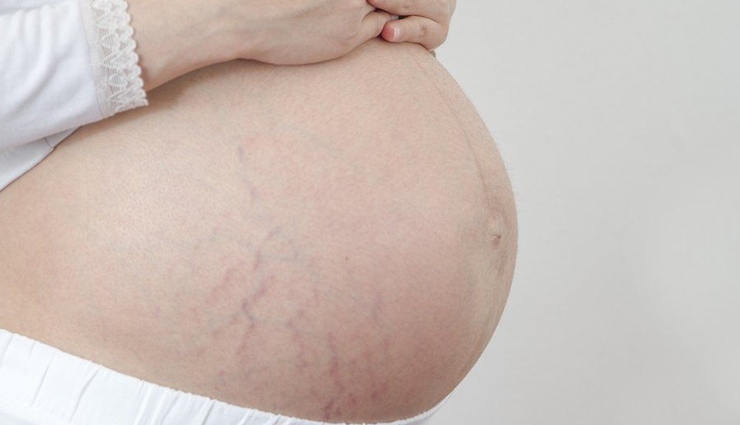7 Best Ways To Avoid Stretch Marks During Pregnancy
By: Priyanka Maheshwari Mon, 21 Dec 2020 1:22:27

Between 50 and 90% of pregnant women develop stretch marks during their pregnancy, so if you are noticing stretch marks developing you are far from being alone. They tend to develop most rapidly during the final trimester of the pregnancy when there is the most growth of the baby, but they can develop at any time and in areas other than around your stomach.
Stretch marks are the results of your body growing in size at a rate which the skin cannot keep up with, meaning it stretches beyond its limits of elasticity. They are scars which form deep within the skin layers and usually start out a purple color, eventually fading to a silvery/white color.
Stretch marks are harmless, but sometimes can cause discomfort as they occur, and some women may find that having stretch marks can affect their self-confidence. If you are feeling down about getting stretch marks during pregnancy, remember that it is perfectly normal, and you are among the majority. It will not affect your baby and will become less noticeable with time. They are a sign of the wonderful achievement your body has accomplished.

# Stay Hydrated
Keeping hydrated will help your skin stay supple. Current recommendations are for an average woman to drink at least 8 cups of water per day, which amounts to 64 fluid ounces or just under 2 liters.
In pregnancy, it is suggested you should be drinking 6 to 8 medium cups of fluid per day, which is 40 – 54 fluid ounces or just under 1.2 – 1.6 liters.
This may be easier said than done as morning sickness can make this difficult, but try to sip little and often to maintain your hydration, particularly if you are suffering from morning sickness. Staying hydrated also helps with other elements of your pregnancy, for example preventing urinary tract infections (UTIs), easing headaches and constipation and may reduce fatigue.

# Eat Well
Similar to staying hydrated, maintaining a healthy diet can be difficult in pregnancy, again due to morning sickness, cravings or food aversion. Certain types of food are particularly good for your skin, including fatty acids like Omega-3 which are found in oily fish, zinc, antioxidants, vitamins and minerals. You will likely be paying more attention to your diet while you are pregnant anyway, and the best way to get them into your body is by eating foods rich in them, rather than taking supplements, but this can’t always be helped.

# Manage Your Weight Gain
Weight gain during pregnancy is inevitable. Women will typically gain between 1 and 5 pounds (0.4-2.2 kg) during the first trimester, and about 1 pound (0.4kg) each subsequent week. It is a common misconception that when pregnant you should eat for two, however, this is not the case.
An average healthy, non-pregnant woman is advised to eat 2000 calories per day, and pregnant women need only increase this by 200 calories per day, although this will be more for those carrying twins. By eating healthily and controlling the weight you put on, you will prevent extra strain being put on your skin and can reduce the formation of stretch marks.

# Get Some Vitamin D
A study by Koehler Zanella et al. found a correlation between low levels of vitamin D and the occurrence of stretch marks. While this still requires more research, by including a healthy level of vitamin D in your system you may be able to reduce the formation of stretch marks.
The easiest way to get vitamin D into your body is by absorbing sunlight, but you should take care not to burn. You may also find your tolerance of the sun becomes lower because your body feels warmer. Some foods such as cereals, dairy, fish and some types of bread contain vitamin D to help with your intake.

# Coconut Oil
Coconut oil is a very effective moisturizer and can double up as a vegan, natural massage oil! Coconut oil is present in many creams and soaps, so it can be even better to use it neat. It absorbs deeply, quickly into your skin and eliminates dead cells. It contains, vitamin E and fatty acids which can contribute to your skin’s health.
Massage coconut oil into your skin after you have showered or bathed until it is fully absorbed, which shouldn’t take long. As it is natural and not medicated, you can do this as often as three times a day, for round-the-clock hydration. You can continue using it after you have had your baby too.

# Olive Oil
Like coconut oil, olive oil contains vitamin E and antioxidants, as well as healing compounds which can assist the healing process. It can be used as both a preventative and remedy for stretch marks and can be used throughout pregnancy.
For the best results, choose extra virgin olive oil and after you have washed, massage it into the affected area and the leave it on so your skin absorbs the nutrients. It can also help soothe the itchiness of your skin which occurs due to the stretching as you grow.

# Aloe Vera
Aloe vera is well-known for having soothing, healing properties as the gel from aloe vera plants contains enzymes, minerals vitamins and fatty acids. These help your skin’s healing process, restoring skin and preventing stretch marks. If you have an aloe plant, simply cut a leaf and squeeze out the gel from inside. Massage it into the affected or high-risk areas of your skin and then leave it on to absorb. You can do this twice a day.





